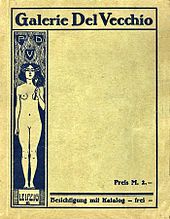Del Vecchio Gallery
The Galerie Del Vecchio was an important Leipzig art dealer that had existed for over 150 years .
history
On October 1, 1799, the Italian Pietro del Vecchio (1768–1829) from Moltrasio in Lombardy opened an “art and short goods store” in a vault in Auerbach's court in Leipzig. Such combinations, i.e. art and soap, braces, toothpicks and the like, were quite common at that time. As for art, in addition to painting, drawings, prints and handicrafts, he also offered picture frames.
After del Vecchio's death, Gotthelf Ehrenfried Süßmilch (1767–1830) took over the action. He moved it to Petersstrasse , acquired a “magazine of mathematical, meteorological, optical and physical instruments” and now called his business “art, optical, short and haberdashery goods”. Under the name Pietro del Vecchio, he founded an “art and publishing company” for prints.
When he died a year later, his widow Dorothea Wilhelmine continued the business, concluded a partnership agreement with the Kramer Carl Heinrich Ploß in 1832 and in 1834 handed over her company shares to her son Otto Süßmilch (1808–1872). After Ploß's death, he managed the company, now as a pure art dealer and publishing company, until 1872. First, he expanded the business area to include picture and mirror frame production, which was licensed by the royal Saxon in 1842. In 1848, the art dealer moved into the Markt 10 building, known as the “Kaufhalle”, where a permanent art exhibition with ongoing temporary exhibitions was established on the second floor. Süßmilch was the first to realize this combination of exhibition and trade in Germany and made "Del Vecchio" the most important art dealer of its time in Leipzig. A friends association with over 1200 members was founded for the exhibition.
After Otto Süßmilch's death, his sons Arnold Ferdinand and Oswald took over the business in 1872. They took up Impressionism , Symbolism and Art Nouveau in exhibitions and trade as the modern directions of that time . In 1881 the title "Royal Saxon Court Art Dealer" was awarded. In 1900, the previous authorized signatory Andreas Fischer-Thorer took over the art dealership, together with the exhibition and frame manufacture, from Arnold Ferdinand Süßmilch and the heirs of Oswald Süßmilch, who had died in 1899.
In the same year, the move to representative rooms in Markgrafenstrasse near Burgplatz took place. Apart from a few exhibitions of modern art from the beginning of the 20th century, Del Vecchio remained more connected to tradition. A flourishing branch of business became the serving of the increasing consumption of pictures by broader sections of the population by reproducing paintings that were framed according to the subject. On December 4, 1943 , the business premises fell victim to the bomb attack on Leipzig. After the Second World War , the Del Vecchio art dealer moved to Thorerstraße in the Leutzsch district (today Paul-Michael-Straße), but was unable to really recover from the aftermath of the war and ceased business in 1953 after 154 years of existence. After the decision to build up socialism in the GDR announced at the Second Party Conference in 1952 , there was probably no more room for a bourgeois art trade.
literature
- Karsten Hommel: Pietro del Vecchio - a royal Saxon court art dealer . In: Leipziger Blätter . No. 52. Passage-Verlag, 2008, ISSN 0232-7244 , p. 24-26 .
- Karsten Hommel: "Pietro Del Vecchio". On the history of a Leipzig art dealer 1799–1953 . In: Central German yearbook for culture and history . tape 11 . German Foundation for Monument Protection Monuments Publications, 2004, ISSN 0946-3119 , p. 89-112 .
Web links
Individual evidence
- ↑ WorldVitalRecords ( Memento from May 14, 2014 in the Internet Archive )


